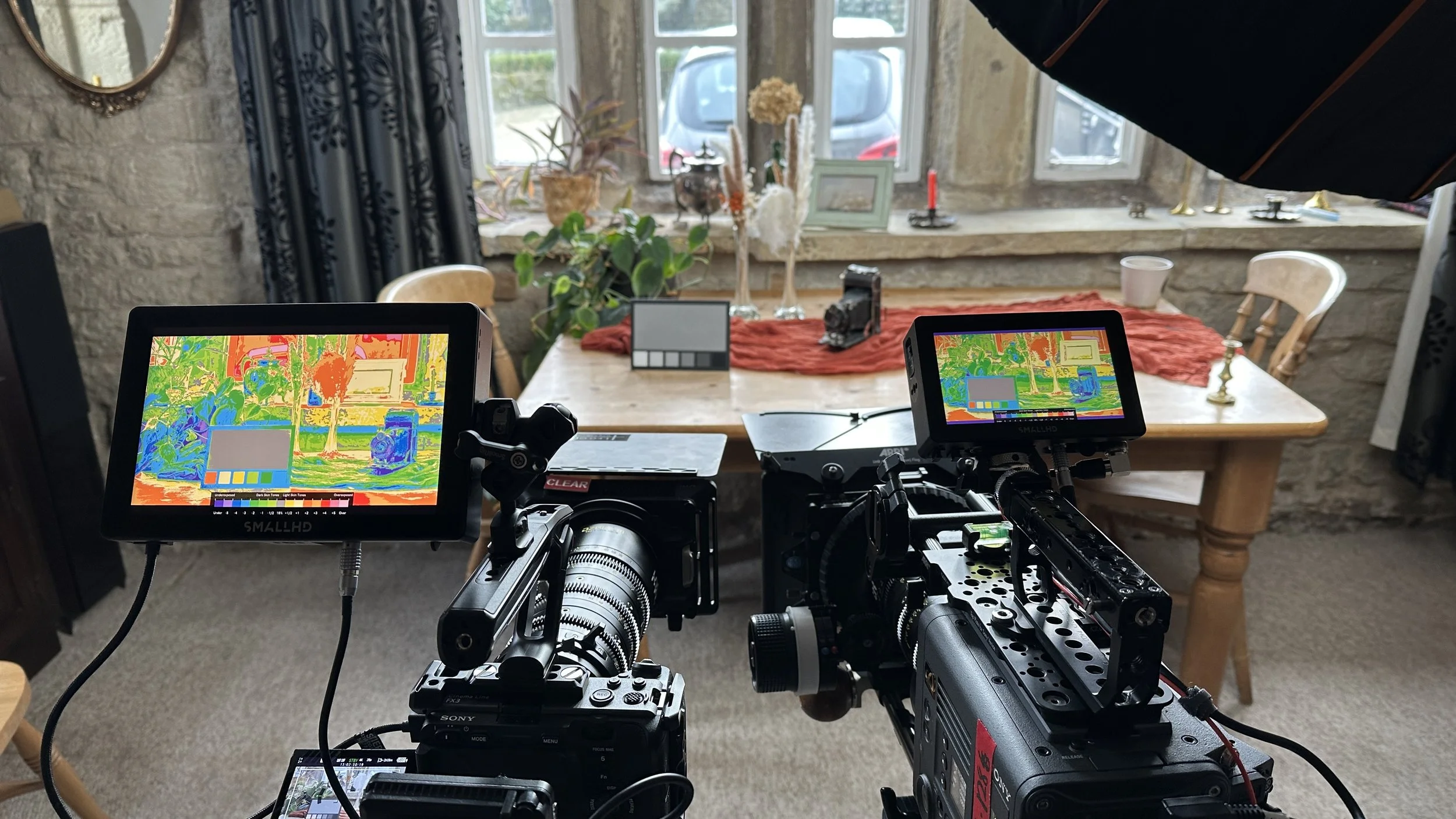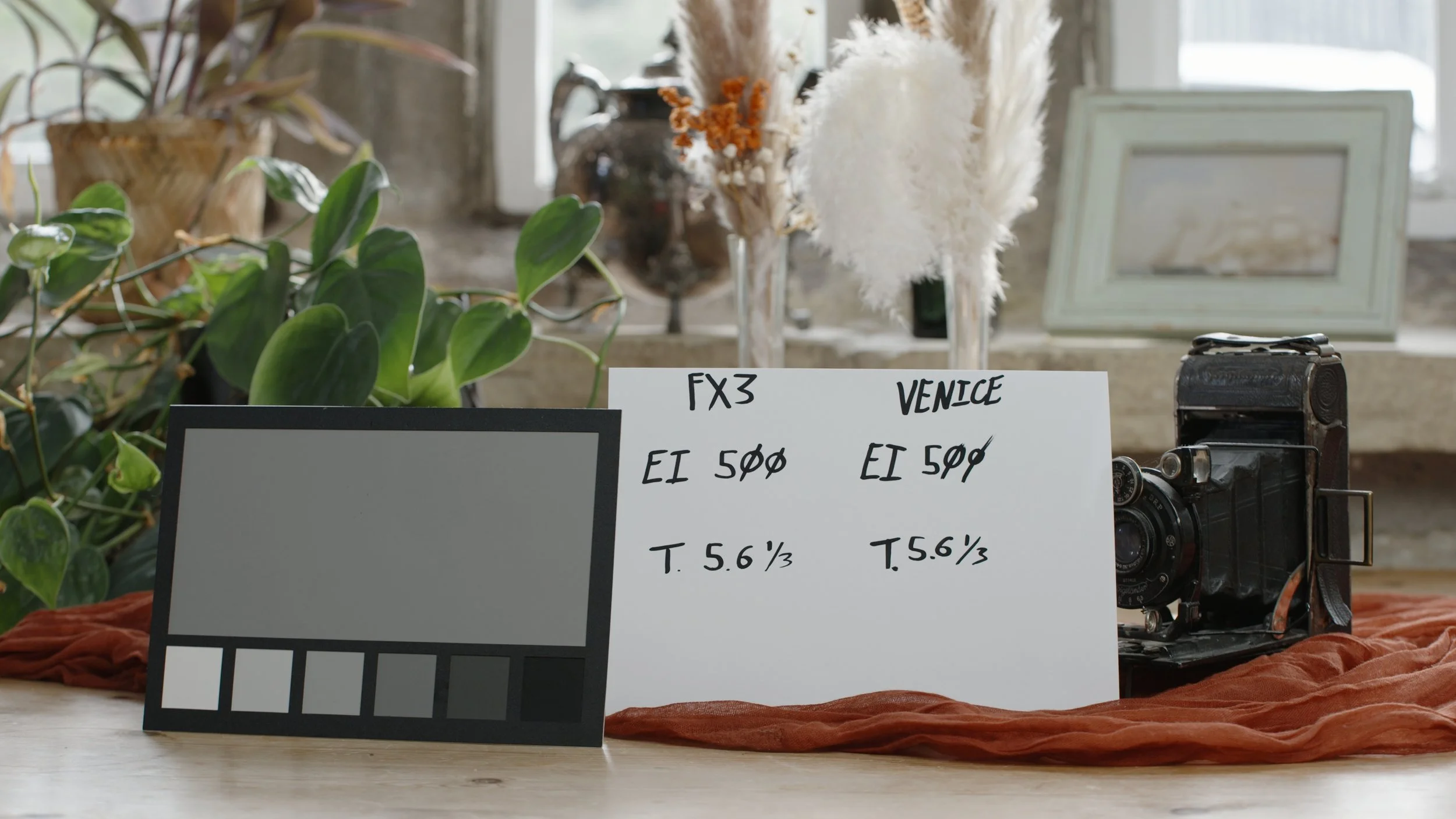Comparing the EI of Sony Venice & FX3: Latitude and Sensor Noise/Grain
This isn’t about winners or losers. It’s not a contest. The Sony Venice and the FX3 exist in different spheres of the industry, each built for a purpose, each delivering stunning images in its own way. The goal here? To see how they can work together—how their colours, textures, noise, and dynamic range can align to tell a cohesive visual story.
Sony cameras have their quirks. Two base EI modes—low and high—serve different needs. Low base is your everyday workhorse, built for normal shooting conditions. High base? That’s for when the shadows creep in, for when you need the camera to be less sensitive to light, not more. It’s a delicate dance between exposure and noise, between what you gain and what you sacrifice.
On paper, the results might seem predictable. But real-world testing is where the truth lives. It’s one thing to assume—another to know. If you're mixing these two cameras on a project, you want confidence in your choices, not just educated guesses.
So, I set out to explore how different EI settings affect dynamic range, latitude, and that razor-thin balance between texture and noise. Both cameras were set to record in X-AVC I, shooting in S-Log, exposed to 18% middle grey at 25fps with a 180-degree shutter angle.
The FX3’s EI was applied in-camera using flexible mode. The Venice? Its EI was set in post, using DaVinci Resolve’s raw camera tab, ensuring proper adjustments were made automatically. Two cameras, two workflows—one goal: to understand how they see the world and how they can work in harmony.
EL Zone exposure monitoring on two calibrated SmallHD monitors ensured accuracy, with each monitor input being Slog3.Cine.
A note on terminology: when I say "texture," I generally mean something pleasing—an element that breathes life into an image rather than disrupting it. "Noise," on the other hand, is the enemy. It distracts, degrades, and chips away at the perceived quality of the image - hope that helps.
A heartfelt thanks to Leo Green for lending a hand in this deep dive - he provided the FX 3, his time and expertise.
Shot 1 - FX 3 / Shot 2 - Venice
Test Results
250 EI
Minimal—if any—noise. The highlight roll-off on the Venice had a certain softness, evident when viewed through EL Zone or a waveform, but in practical terms, the difference was negligible. Both cameras held their highlights ok. No hesitation in rating either at 250 in darker situations.
FX 3
Venice
500 EI
The Venice, being at its native 500, presented a touch, and I mean the smallest of touches, more texture, but not in a way that felt intrusive. Highlight retention? Virtually identical to one another and compared to 250 visually similar with only the waveform showing a smoother fall off.
FX 3
Venice
800 EI
The results are almost identical to test at 500. At 800 both cameras look similar, the Venice has more texture, but not noise, it has the advantage of retaining a little more exposure latitude but it's indiscernible in these tests, although when compared to test at 250 EI there is a a little more information present, not much, but a little.
Much like 500, the Venice held slightly more exposure latitude than the FX 3, but the real-world impact is minimal.
FX 3
Venice
1000 EI
FX3: Still crisp, a whisper more noise than at 800.
Venice: Clean, but here the texture starts creeping up, hovering somewhere around a naturally, organic grain. The Venice also benefits from an extra stop of overexposure latitude, visible on a waveform but not overly apparent in the image itself. Would happily rate both cameras at 1000 EI, no need for post noise reduction.
FX 3
Venice
Only in direct comparison with 250 EI did a subtle retention of detail emerge in out-of-focus highlights - scopes below.
2000 EI
Texture starts making itself at home on the Venice. The FX3 leans towards noise, though still at a manageable level.
The Venice, on the other hand, delivers something that feels deliberate, almost like a well-balanced film stock. Both cameras could be matched easily with noise reduction applied to the FX and an added grain layer.
FX 3
Venice
2500 EI (FX3 in Low Base, Venice in High Base)
FX3: Noise present, still usable, but at this stage, I’d suggest NR in post.
Venice: Now in High Base at 2500, it’s actually exhibiting less grain than at 2000 in Low Base. If shooting at these levels, it’s wise to switch the Venice to High Base at 2000 or (even 2500) ISO for a cleaner image that using the Low Base to 2000.
Compared side by side, the Venice maintains a polished, uniform texture while the FX3 needs a bit of cleanup to match. Highlight retention? Practically even to the eye but a very, very minor highlight roll off on the scopes in favour of the FX 3.
FX 3
Venice
1250 EI (FX 3 Low Base, Venice in High Base)
The FX3 should, in theory, have a slight overexposure edge—by about 2/3 of a stop. But in reality? Unnoticeable even on scopes. The Venice at 1250 EI in High Base delivers a light, refined texture. A perfect match for the FX3 in a higher Low Base EI.
I would suggest using the 1250 High Base exposure on the Venice for scenes such as night time interiors, where you need the extra sensitivity but still want a clean image.
FX 3
Venice
5000 EI (FX3 at 5000 High Base, Venice at 5000, also High Base)
FX3: Below its native EI of 12,800, it does exhibits more noise than at 2500 in the Low Base. Still usable, but now we're seeing the image starting to become stretched.
Venice: More texture here too, but it has a film-like quality that feels intentional and apart of the image rather than intrusive.
For best results, I’d clean up the FX3 and add grain to match the Venice rather than stripping texture from the Venice in post.
FX 3
Venice
10,000 EI (High Base, both cameras)
FX3: A large amount of noise, but still treatable with NR in Davinci.
Venice: Topping out at 10,000 in High Base, it’s textured—but not unpleasantly so. Would I shoot at this level? Only if I were intentionally leaning into that gritty/grainy aesthetic.
FX 3
Venice
10. 12,800 ISO (FX3 HB, Venice at 2500 HB)
FX3: Considerable noise. Venice: At 2500 HB, it remains noticeably cleaner. The texture is controlled, the speckled noise pattern of the FX3 stands out in direct comparison. NR and added grain could bring them together.
FX 3
Venice
11. FX3 at 1000 ISO vs. Venice at 500 ISO (Low Base Comparison)
A near-perfect match. I’d confidently rate the FX3 at 1000 ISO for seamless integration with a Venice at native 500.
FX 3
Venice
12. FX3 at 12,800 ISO vs. Venice at 5000 ISO (High Base Comparison)
Venice at 5000 HB appears significantly cleaner than the FX3 at native 12,800. The FX3 requires NR and some grain for cohesion.
FX 3
Key Takeaways
For those who want the full detail—grain, noise, and all—the full ProRes file is available for download on Vimeo, as the Vimeo H.264 compression might not do it justice.
If you are handing off images and have little to no control over the post-production pipeline, a safe bet is to rate the FX3 between 1000-2000 EI and pair it with the Venice at 500-1000 EI. Noise reduction won’t be required, and your images will match well straight out of the camera.
If you are handling post-production, the FX3 can be comfortably pushed to 6400 EI, giving you plenty of additional headroom if you are lighting to a Venice EI Low Base of 500-1000. For me, this setup makes the most sense when using the FX3 as a B-camera on a longer lens, where you might need 2-3 extra stops to better control depth of field. With control in post, the Venice can be pushed to 2000 in Low Base and up to 3200 in High Base, then cleaned up with noise reduction. While NR could be applied to the Venice at 5000-10,000 EI, I would only use this in a pinch or if a specific look is required.
In Low Base, the Venice holds strong up to 1000 EI without the need for post noise reduction. At 1000-2000 EI in Low Base and 1250-2500 in High Base, texture remains organic rather than disruptive. I wouldn’t be too concerned using these settings without noise reduction, but it can be easily cleaned up if needed.
Personally, 5000 EI is the highest I’d push the Venice while maintaining a pleasing texture—unless you’re after a gritty, baked-in grain aesthetic.
With either camera, there is little to gain by shooting under 250 EI.
Dynamic range shifts are visible on a waveform when exposing above native EI. When shooting two cameras simultaneously, I suggest avoiding mismatches in highlight allocation—such as rating the FX3 at 2000-2500 EI in Low Base and the Venice at 1250 in High Base. That said, in real-world scenarios, the visual impact of this mismatch is minimal and largely depends on the scene, lighting, and the level of post-processing required.
The FX3 (and by extension, the FX6, which shares the same sensor) is a powerhouse. It may not have the Venice’s subtle highlight roll-off or refined texture, but for its size and price, it’s a workhorse—especially in the hands of a colorist who knows their way around DaVinci Resolve.
Nearly six years on, the Venice remains one of the best digital cinema cameras ever made—versatile, with a useful ISO range that adapts to artistic vision. Put simply, when exposed well, it doesn’t make a bad image, no matter the settings.
And if you’re looking for a perfect pairing? The FX line makes an excellent B-camera to the Venice—or even the other way around.



























